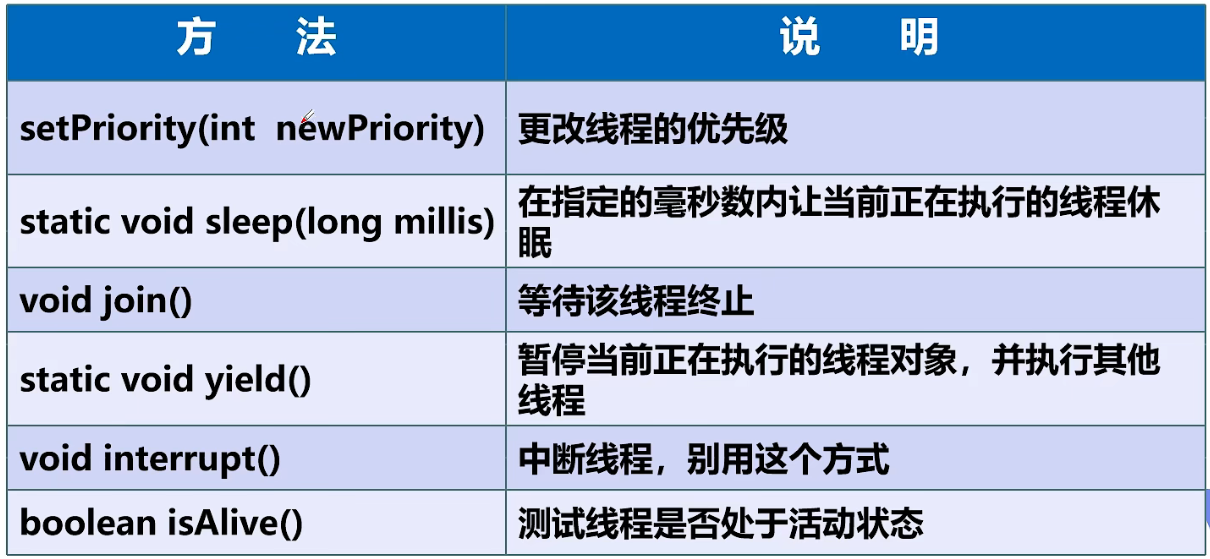文章目录
线程状态

线程有五大状态:
- 创建状态 :new
- 就绪状态 :start( )
- 阻塞状态:sleep( ) wait( ) lock( ) synchronized( )
- 运行状态:CPU调度执行
- 死亡状态:线程终止

线程方法

> 停止线程 stop( )
- 不建议使用JDK提供的 stop( )、destroy( ) 【已废弃】;
- 建议 让线程自己停下来;
- 即:使用一个标志位进行终止变量,当 flag=false ,则终止线程运行;
- 建议线程正常停止,利用次数,不建议死循环;
- 建议使用标志位 flag 判断;
- 不要使用 stop( )或者 destroy( ) 等过时JDK不建议使用的方法;
public class TestStop implements Runnable{
//1.设置一个标识位
private boolean flag = true;
@Override
public void run() {
int i = 0;
while(flag){
System.out.println("run...Thread "+i++);
}
}
//2.设置一个公开的方法停止线程,转换标志位
public void stop(){
//自定义的停止方法
this.flag = false;
}
public static void main(String[] args) {
//创建Runnable实现类对象,通过线程对象开启线程
TestStop testStop = new TestStop();
new Thread(testStop).start();
for (int i = 0; i < 1000; i++) {
System.out.println("main线程 "+i);
if (i==900){
//调用stop方法切换标志位,让线程停止
testStop.stop();
System.out.println("线程停止");
}
}
}
}
> 线程休眠 sleep( )
- sleep( ) 指定当前线程阻塞的毫秒数;sleep(毫秒数)
- sleep存在异常 InterruptedException;
- sleep时间达到后,线程进入就绪状态;
- sleep可以模拟网络延时,倒计时等;
- 每个对象都有一个锁,sleep不会释放锁;
1 秒 = 1000 毫秒
倒计时 10、9、8 … 2、1 :
public class TestSleep implements Runnable {
@Override
public void run() {
for (int i = 10; i > 0; i--) {
System.out.println(i);
try {
Thread.sleep(1000);
} catch (InterruptedException e) {
throw new RuntimeException(e);
}
}
}
public static void main(String[] args) {
TestSleep testSleep = new TestSleep();
new Thread(testSleep).start();
}
}
> 线程礼让 yield( )
- 礼让线程,让当前正在执行的线程暂停,但不阻塞;
- 将线程从 运行状态 为 就绪状态 ;
- 让CPU重新调度,礼让不一定成功,看CPU心情;
//测试礼让线程
//礼让不一定成功,看CPU心情
public class TestYield {
public static void main(String[] args) {
MyYield myYield = new MyYield();
new Thread(myYield,"a").start();
new Thread(myYield,"b").start();
}
}
class MyYield implements Runnable{
@Override
public void run(){
System.out.println(Thread.currentThread().getName()+"线程开始执行");
Thread.yield();
System.out.println(Thread.currentThread().getName()+"线程停止执行");
}
}
运行结果如下(多种):



> 线程强行执行 join( )
- Join 合并线程,待此线程执行完成后,再执行其他线程,其他线程阻塞;
- 可以理解为 “ 插队 ”
//测试join方法 相当于“插队”
public class TestJoin implements Runnable{
@Override
public void run() {
for (int i = 0; i < 1000; i++) {
System.out.println("线程 BOSS 来啦"+i);
}
}
public static void main(String[] args) throws InterruptedException {
//启动线程
TestJoin testJoin = new TestJoin();
Thread thread = new Thread(testJoin);
thread.start();
//主线程
for (int i = 0; i < 500; i++) {
if(i==200){
thread.join();//线程插队
}
System.out.println("main "+i);
}
}
} //如果子线程会穿插在主线程中,可以在run()中加个sleep()
/*
main 0
main 1
...
main 198
main 199
线程 BOSS 来啦0
线程 BOSS 来啦1
线程 BOSS 来啦2
...
线程 BOSS 来啦998
线程 BOSS 来啦999
main 200
main 201
...
main 498
main 499
*/
> 线程状态观测 Thread.State

//观察线程状态
public class TestState {
public static void main(String[] args) throws InterruptedException {
Thread thread = new Thread(()->{
//Lambda表达式
for (int i = 0; i < 5; i++) {
try {
Thread.sleep(1000);
} catch (InterruptedException e) {
throw new RuntimeException(e);
}
}
System.out.println("-------------");
});
//观察状态
Thread.State state = thread.getState();
//观察启动后
thread.start();
state = thread.getState();
System.out.println(state);//Run
//只要线程不终止,就一直输出状态
while(state!=Thread.State.TERMINATED){
Thread.sleep(100);
state = thread.getState();//更新线程状态
System.out.println(state);//输出状态
}
thread.start();
}
}
/* 输出:
RUNNABLE
TIMED_WAITING
TIMED_WAITING
......
TIMED_WAITING
-------------
TERMINATED
*/
> 线程的优先级 Priority
- Java提供一个线程调度器来监控程序中启动后进入就绪状态的所有线程,线程调度器按照优先级决定应该调度哪个线程来执行;
- 线程的优先级用数字表示,范围从 1 ~ 10 .
- Thread.MIN_PRIORITY = 1 ;
- Thread.MAX_PRIORITY = 10 ;
- Thread.NORM_PRIORITY = 5 ;
- 使用以下方法改变或获取优先级:
- getPriority( ) 、 setPriority( int x)
//测试线程的优先级
public class TestPriority {
public static void main(String[] args ){
//主线程默认优先级
System.out.println(Thread.currentThread().getName()+"--->Priority "+
Thread.currentThread().getPriority());
MyPriority myPriority = new MyPriority();
Thread t1 = new Thread(myPriority);
Thread t2 = new Thread(myPriority);
Thread t3 = new Thread(myPriority);
Thread t4 = new Thread(myPriority);
//先设置优先级,再启动
t1.start();
t2.setPriority(1);
t2.start();
t3.setPriority(4);
t3.start();
t4.setPriority(Thread.MAX_PRIORITY);//MAX_PRIORITY=10
t4.start();
}
}
class MyPriority implements Runnable{
@Override
public void run() {
System.out.println(Thread.currentThread().getName()+
"--->Priority "+Thread.currentThread().getPriority());
}
}
/*
main--->Priority 5
Thread-0--->Priority 5
Thread-3--->Priority 10
Thread-2--->Priority 4
Thread-1--->Priority 1
进程已结束,退出代码0
*/
优先级低只是意味着获得调度的概率低,并不是优先级低就不会被调用,都是看CPU的调度
> 守护多线程 daemon
- 线程分为 用户线程 和 守护线程 ;
- 虚拟机必须确保用户线程执行完毕;
- 虚拟机不用等待守护线程执行完毕;
- 如:后台记录操作日志,监控内存,垃圾回收…等等;
守护线程是程序运行的时候在后台提供一种通用服务的线程。
所有用户线程停止,进程才会停掉所有守护线程,退出程序。
//测试守护线程
//上帝守护你
public class TestDaemon {
public static void main(String[] args) {
God god = new God();
You you = new You();
Thread thread = new Thread(god);
thread.setDaemon(true);//默认是false表示是用户线程,正常的线程都是用户线程
thread.start();
new Thread(you).start();//你 用户线程启动
}
}
//上帝
class God implements Runnable{
@Override
public void run(){
while(true){
System.out.println("上帝保佑你");
}
}
}
//你
class You implements Runnable{
@Override
public void run(){
for (int i = 0; i < 36500; i++) {
System.out.println("开心快乐的活着");
}
System.out.println("--> goodbye world <--");
}
} //可以自己运行一下,很有意思